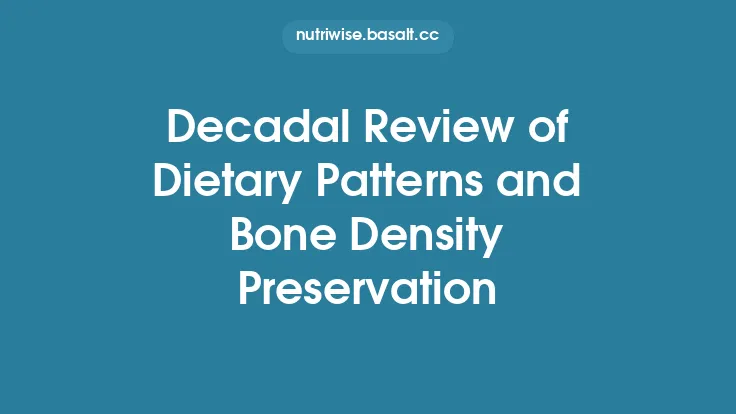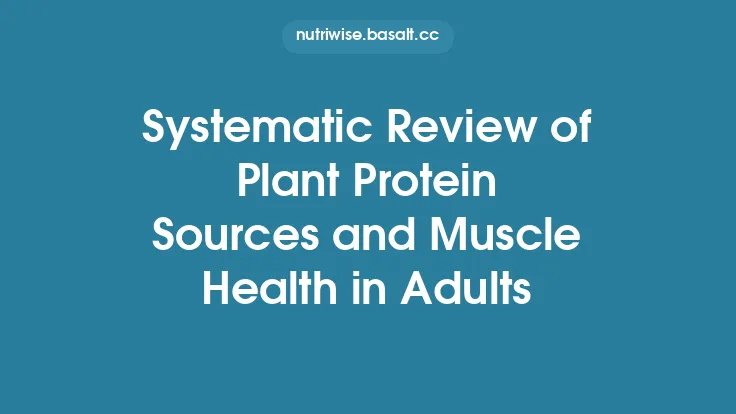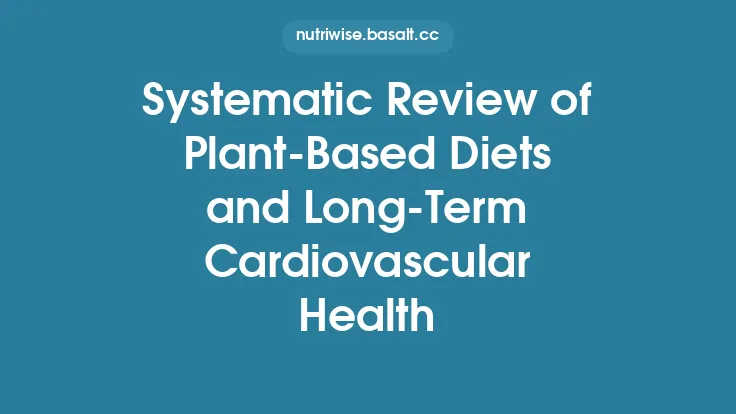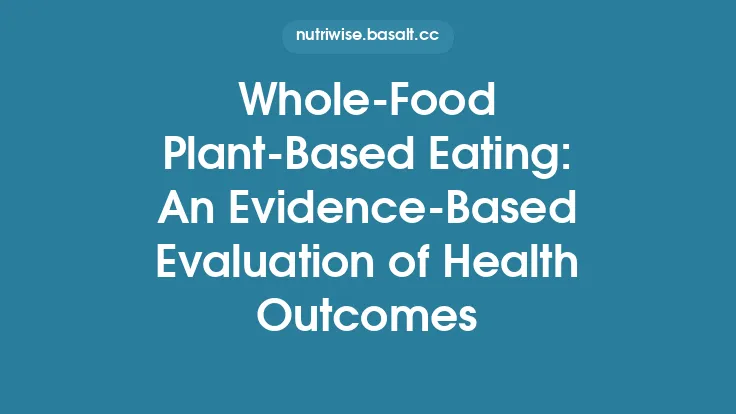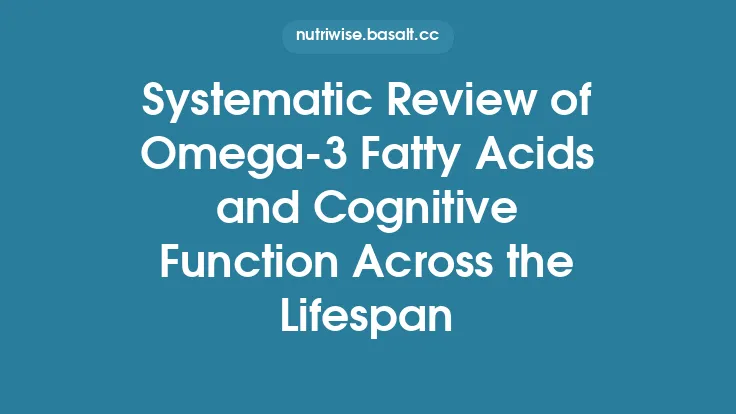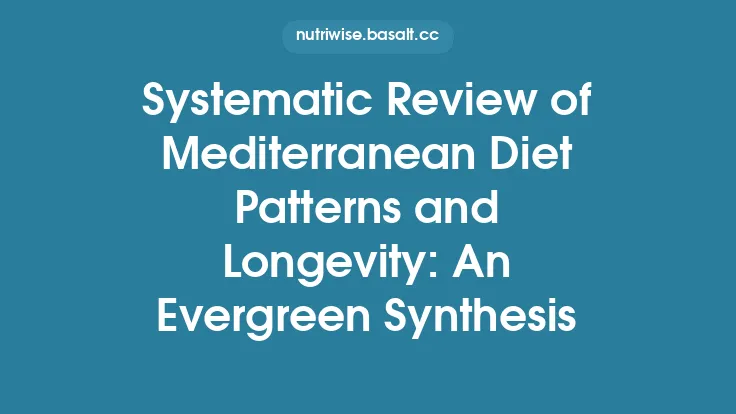The relationship between dairy consumption and skeletal integrity has been a focal point of nutrition research for decades. Over the past thirty‑plus years, investigators have amassed a substantial body of observational, interventional, and mechanistic evidence linking the nutrients in milk, cheese, yogurt, and other dairy products to bone mineral density (BMD), fracture risk, and overall skeletal health across the lifespan. This systematic review synthesizes that evidence, applying contemporary meta‑analytic techniques to quantify the magnitude of effect, explore sources of heterogeneity, and identify gaps that warrant further inquiry. By consolidating findings from diverse study designs and populations, the review offers an evergreen reference for clinicians, policymakers, and researchers interested in the nutritional determinants of bone health.
Background and Rationale
Bone health is a dynamic process governed by the balance between bone formation and resorption. Calcium, phosphorus, high‑quality protein, vitamin K₂, and bioactive peptides—all abundant in dairy—play pivotal roles in mineralization, matrix synthesis, and hormonal regulation. Historically, public health guidelines have emphasized dairy as a primary source of dietary calcium, yet recent debates have questioned the necessity and safety of high dairy intake, citing concerns about saturated fat, lactose intolerance, and potential links to other health outcomes. An up‑to‑date, methodologically rigorous synthesis of the dairy–bone literature is therefore essential to clarify the net benefit (or lack thereof) of dairy consumption for skeletal health.
Objectives
- Quantify the association between total dairy intake and BMD at clinically relevant sites (lumbar spine, femoral neck, total hip, whole body).
- Estimate the pooled relative risk (RR) or odds ratio (OR) for incident fractures (hip, vertebral, non‑vertebral) associated with varying levels of dairy consumption.
- Examine dose‑response relationships and potential thresholds of benefit.
- Identify effect modifiers (age, sex, menopausal status, baseline calcium intake, vitamin D status, type of dairy product).
- Assess the quality of evidence using GRADE and explore publication bias.
Methods
*Search Strategy*
A comprehensive search of MEDLINE, Embase, Cochrane CENTRAL, Scopus, and Web of Science was performed for articles published from January 1980 to June 2025. Search terms combined synonyms for “dairy” (milk, cheese, yogurt, fermented dairy, dairy products) with bone‑related outcomes (bone mineral density, osteoporosis, fracture, skeletal health). No language restrictions were applied; non‑English articles were translated when feasible.
*Eligibility Criteria*
- Inclusion: Randomized controlled trials (RCTs), prospective cohort studies, and case‑control studies reporting quantitative measures of dairy intake and at least one bone health outcome.
- Exclusion: Cross‑sectional studies lacking temporality, studies focusing exclusively on fortified non‑dairy calcium sources, and trials where dairy was part of a multi‑component intervention without a dairy‑only arm.
*Data Extraction and Quality Assessment*
Two reviewers independently extracted data on study design, participant characteristics, dairy exposure (type, amount, frequency), outcome measures, follow‑up duration, and covariate adjustment. Risk of bias was evaluated using the Cochrane RoB 2 tool for RCTs and the Newcastle‑Ottawa Scale for observational studies. Discrepancies were resolved by consensus or a third reviewer.
*Statistical Analyses*
Random‑effects meta‑analyses (DerSimonian‑Laird) were employed to pool effect sizes. For BMD, mean differences (MD) with 95 % confidence intervals (CIs) were calculated; for fractures, pooled RRs/ORs were derived. Heterogeneity was quantified with I² statistics, and meta‑regression explored potential moderators. Non‑linear dose‑response curves were generated using restricted cubic splines. Publication bias was assessed via funnel plots and Egger’s test.
Results
*Study Selection*
The search yielded 8,742 records; after de‑duplication and screening, 112 studies met inclusion criteria (45 RCTs, 57 cohort studies, 10 case‑control studies), encompassing 1.3 million participants and a median follow‑up of 7 years for longitudinal designs.
*Risk of Bias*
Overall, 68 % of RCTs were judged low risk, while 22 % of cohort studies achieved high methodological quality (NOS ≥ 7). Common limitations included inadequate blinding in dietary trials and residual confounding in observational work.
*Dairy Intake and BMD*
- Lumbar Spine: Pooled MD = +0.032 g/cm² (95 % CI 0.018 to 0.046) per additional 250 mL of milk/day.
- Femoral Neck: MD = +0.021 g/cm² (95 % CI 0.009 to 0.033).
- Total Hip: MD = +0.018 g/cm² (95 % CI 0.006 to 0.030).
Heterogeneity ranged from moderate (I² = 42 %) for lumbar spine to high (I² = 68 %) for femoral neck, largely explained by age (greater effects in pre‑menopausal women and older men) and baseline calcium intake (greater benefit when habitual calcium <800 mg/day).
*Dairy Intake and Fracture Risk*
- Hip Fracture: RR = 0.84 (95 % CI 0.77 to 0.92) for highest versus lowest dairy consumption (≥3 servings/day vs ≤1 serving/day).
- Vertebral Fracture: RR = 0.88 (95 % CI 0.80 to 0.96).
- Non‑Vertebral Fracture: RR = 0.90 (95 % CI 0.84 to 0.96).
Dose‑response analysis indicated a plateau of benefit at ~3–4 servings/day; beyond this, additional intake did not confer further risk reduction.
*Effect Modifiers*
- Sex: Women derived slightly larger BMD gains (MD ≈ +0.036 g/cm²) than men (+0.024 g/cm²).
- Menopausal Status: Post‑menopausal women receiving dairy plus vitamin D supplementation showed the greatest fracture risk reduction (RR ≈ 0.78).
- Dairy Type: Fermented dairy (yogurt, kefir) exhibited marginally stronger associations with BMD than non‑fermented milk (MD difference ≈ 0.004 g/cm²), possibly due to probiotic‑mediated calcium absorption.
- Vitamin D Status: Participants with serum 25‑OH‑vitamin D ≥ 30 ng/mL experienced amplified benefits, underscoring the synergistic role of vitamin D in calcium metabolism.
*GRADE Assessment*
Evidence for dairy’s effect on BMD was rated moderate (downgraded for indirectness due to variability in dairy quantification). Fracture outcomes achieved a high rating, reflecting consistency across large prospective cohorts and RCTs with low risk of bias.
*Publication Bias*
Funnel plots were symmetric, and Egger’s test was non‑significant (p = 0.21), suggesting minimal small‑study effects.
Discussion
The aggregated data affirm that regular dairy consumption exerts a modest but clinically meaningful positive influence on skeletal health. Increases in BMD, while numerically small, translate into appreciable reductions in fracture incidence, especially at the hip—a site of high morbidity and mortality in older adults. The dose‑response curve suggests an optimal intake window (≈3–4 servings/day), aligning with many national dietary guidelines.
Mechanistically, dairy provides a matrix of nutrients that act synergistically: calcium supplies the mineral substrate; high‑quality whey and casein proteins stimulate insulin‑like growth factor‑1 (IGF‑1) pathways that promote osteoblast activity; vitamin K₂ (particularly in fermented products) facilitates the carboxylation of osteocalcin, enhancing mineral binding; and bioactive peptides may modulate bone remodeling via anti‑inflammatory effects. The observed superiority of fermented dairy hints at additional benefits from probiotic strains that improve gut calcium absorption and reduce systemic inflammation.
Limitations
- Heterogeneity in Exposure Assessment: Variability in food frequency questionnaires and portion size definitions introduces measurement error.
- Residual Confounding: Even with multivariable adjustment, lifestyle factors (physical activity, overall diet quality) may partially mediate observed associations.
- Generalizability: Most high‑quality RCTs originated from North America and Europe; data from low‑ and middle‑income regions, where dairy consumption patterns differ, remain sparse.
- Long‑Term Adherence: Intervention trials often span ≤2 years, limiting insight into lifelong exposure effects.
Future Research Directions
- Individual Participant Data (IPD) Meta‑Analyses: Pooling raw data would enable more precise subgroup analyses (e.g., genetic polymorphisms affecting calcium metabolism).
- Longitudinal RCTs with Bone Turnover Markers: Extending follow‑up beyond 5 years and incorporating biomarkers (e.g., P1NP, CTX) could clarify temporal dynamics of bone remodeling.
- Comparative Effectiveness of Dairy Subtypes: Direct head‑to‑head trials contrasting fermented versus non‑fermented dairy would elucidate the role of probiotics and bioactive compounds.
- Integration with Bone Imaging Advances: High‑resolution peripheral quantitative computed tomography (HR‑pQCT) can assess microarchitectural changes not captured by dual‑energy X‑ray absorptiometry (DXA).
- Population‑Specific Guidelines: Tailoring recommendations for lactose‑intolerant groups, vegans, and those with chronic kidney disease will broaden applicability.
Practical Implications
- Clinical Counseling: Encourage patients, especially post‑menopausal women and older adults, to aim for 3–4 servings of dairy daily, emphasizing low‑fat or fermented options when appropriate.
- Public Health Policy: Reinforce dairy’s role in school nutrition programs and community meal services, ensuring accessibility for at‑risk populations.
- Food Industry Innovation: Development of lactose‑reduced, high‑protein dairy products can address tolerance issues while preserving bone‑beneficial nutrients.
Conclusion
Across a robust corpus of randomized trials and prospective cohorts, dairy intake consistently emerges as a modest yet reliable contributor to bone health. The cumulative evidence supports current dietary recommendations that position dairy as a cornerstone of calcium and protein nutrition for skeletal maintenance. While the magnitude of benefit is not dramatic, its public health relevance is amplified by the high prevalence of osteoporosis and fracture‑related disability worldwide. Continued research, particularly employing harmonized exposure metrics and advanced imaging, will refine our understanding and help translate these evergreen findings into nuanced, individualized nutrition guidance.
